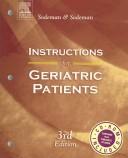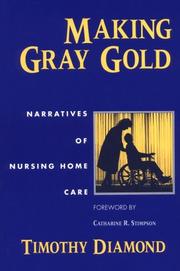| Listing 1 - 10 of 19 | << page >> |
Sort by
|

ISBN: 1416002030 9781437710342 1437710344 9781416002031 Year: 2005 Publisher: [Place of publication not identified] Elsevier Saunders
Abstract | Keywords | Export | Availability | Bookmark
 Loading...
Loading...Choose an application
- Reference Manager
- EndNote
- RefWorks (Direct export to RefWorks)
Patient Education as Topic. --- Caregivers. --- Geriatrics. --- Gerontology --- Care Givers --- Carers --- Family Caregivers --- Spouse Caregivers --- Care Giver --- Caregiver --- Caregiver, Family --- Caregiver, Spouse --- Caregivers, Family --- Caregivers, Spouse --- Carer --- Family Caregiver --- Spouse Caregiver --- Education, Patient --- Education of Patients --- Patient Education --- Patients --- Patient Participation --- Health Literacy --- education --- Caregiver Burden
Book
Year: 2018 Publisher: Frontiers Media SA
Abstract | Keywords | Export | Availability | Bookmark
 Loading...
Loading...Choose an application
- Reference Manager
- EndNote
- RefWorks (Direct export to RefWorks)
The number of older subjects is rapidly increasingly worldwide. As a consequence, the nature of clinical conditions is also changing. Traditional medicine and models of care have been based on the evaluation and treatment of single and usually acute conditions occurring in relatively young individuals. Today, the usual clinical manifestation of diseases is characterized by multiple and often chronic conditions affecting older people. In this scenario, frailty and dementia have been triggering special interest both in research and clinical settings due to their high prevalence, impact on the individual’s quality of life, and consequences for public health worldwide. These conditions aptly reflect the complexity of age-related pathological conditions, finding as causal factor a myriad of heterogeneous, interacting, and often still unclear pathophysiological processes. Indeed, their study is strongly affected by the difficulty to differentiate the effects of a normal aging process from eventual pathological deviations of the underlying systems. Their occurrence and trajectories over time are strongly affected by a wide array of factors and determinants that can be hardly attributed to the deficit/involvement of single biological systems and/or health domains. Moreover, environment and social factors also play a key role in the determination of phenotypes. The present Research Topic is aimed at widening our understanding of the frailty and dementia phenomena occurring with aging, in order to improve the clinical and public health approaches to these burdening conditions.
Dementia. --- Aging --- Psychological aspects. --- cognition --- caregiver --- Frailty --- dementia --- mild cognitive impairment --- aging --- cognitive frailty --- Alzheimer
Book
ISBN: 0309156297 9786612917059 0309156300 1282917056 9780309156301 9781282917057 9780309156295 6612917059 0309163366 Year: 2010 Publisher: Washington, DC : National Academies Press,
Abstract | Keywords | Export | Availability | Bookmark
 Loading...
Loading...Choose an application
- Reference Manager
- EndNote
- RefWorks (Direct export to RefWorks)
Home care services --- Caregivers --- Medical personnel-caregiver relationships --- Caregivers and medical personnel --- Medical personnel and caregivers --- Relationships, Medical personnel-caregiver --- Care givers --- Carers --- Family caregivers --- Home health caregivers --- Informal caregivers --- Home health agencies --- Home health care --- Volunteers --- Community health services
Book
ISBN: 1928424171 1928424163 Year: 2018 Publisher: Bloemfontein UJ Press
Abstract | Keywords | Export | Availability | Bookmark
 Loading...
Loading...Choose an application
- Reference Manager
- EndNote
- RefWorks (Direct export to RefWorks)
The authors have developed the ethical imagination inviting a sense of “otherness” towards the vulnerable self, rebounding care for the other as a way to understand our everyday neurotic (normal) tendency of small vices as the propensity and possibility for responsibility towards the other. The authors, inviting the reader into troublesome feelings such as laziness and anger, bring a Levinasian horizon into focus, so that even in the midst of laziness, there remains the small goodness to set the self free to care for the other, meeting the demands, challenges, hesitation, shuddering, tension and shocks of such alterity, of living “otherwise”.
Medical ethics & professional conduct --- caregiver --- philosophy --- science --- caretakers --- philosophers --- morality --- vulnerable --- neurotic --- small vices --- responsibility --- laziness --- anger --- Levinasian --- goodness --- demands --- challenges --- hesitation --- shuddering --- tension --- shock --- vulnerability of the caregiver --- vices for the virtuous caring of the caregiver --- group discussions amongst caregivers --- social sciences --- healthcare
Book
ISBN: 1442689994 9781442689992 9781442641822 1442641827 9781442610927 1442610921 1442699906 Year: 2011 Publisher: Toronto
Abstract | Keywords | Export | Availability | Bookmark
 Loading...
Loading...Choose an application
- Reference Manager
- EndNote
- RefWorks (Direct export to RefWorks)
"To trace the relationships between gender, labour, and equity in health care, the essays in this volume analyse the rules and practices that shape care work. The contributors highlight how national configurations of the welfare state shape the gendering of paid and unpaid intimate labour in a range of settings and discuss how the policies and practices associated with neoliberalism have focussed on efficiency and accountability to the detriment of other policy agendas, including those that might further increase dignity and equity for both recipients and providers of paid and unpaid health care."--Pub. desc. There are many forms of paid and unpaid labour encompassed in health care systems, including home care for the elderly or disabled, community health services, and the care family members provide for loved ones. Valuing Care Work is an international comparative study that examines economic organizations as well as intimate settings to show how personal service work is shaped by broader welfare state developments.
Caregivers. --- Care of the sick. --- Home care services. --- Medical care. --- Home Care Services. --- Delivery of health care --- Delivery of medical care --- Health care --- Health care delivery --- Health services --- Healthcare --- Medical and health care industry --- Medical services --- Personal health services --- Public health --- Home health agencies --- Home health care --- Community health services --- Caring for the sick --- Sick, Care of the --- Sick --- Home nursing --- Care givers --- Carers --- Family caregivers --- Home health caregivers --- Informal caregivers --- Volunteers --- Care Givers --- Family Caregivers --- Spouse Caregivers --- Care Giver --- Caregiver --- Caregiver, Family --- Caregiver, Spouse --- Caregivers, Family --- Caregivers, Spouse --- Carer --- Family Caregiver --- Spouse Caregiver --- Caregiver Burden --- Care Services, Home --- Home Care --- Services, Home Care --- Domiciliary Care --- Home Health Care --- Care, Domiciliary --- Care, Home --- Home Care Service --- Service, Home Care

ISBN: 0674020022 9780674020023 0674003144 9780674003149 0674010159 9780674010154 Year: 2000 Publisher: Cambridge, MA : Harvard University Press,
Abstract | Keywords | Export | Availability | Bookmark
 Loading...
Loading...Choose an application
- Reference Manager
- EndNote
- RefWorks (Direct export to RefWorks)
A study of caregiving in America across ethnic and class divides during the 19th and early 20th century. This book reveals how a complex series of historical changes altered the cultural meaning of care.
Caregivers --- Medical personnel-caregiver relationships --- Women --- Home nursing --- Home care services --- Nursing --- Care of the sick --- Caregivers and medical personnel --- Medical personnel and caregivers --- Relationships, Medical personnel-caregiver --- Care givers --- Carers --- Family caregivers --- Home health caregivers --- Informal caregivers --- Volunteers --- History --- Social conditions.
Book
ISBN: 1443869872 9781443869874 1322216746 9781322216744 1443846031 9781443846035 9781443869874 9781443846035 Year: 2013 Publisher: Newcastle upon Tyne Cambridge Scholars Publishing
Abstract | Keywords | Export | Availability | Bookmark
 Loading...
Loading...Choose an application
- Reference Manager
- EndNote
- RefWorks (Direct export to RefWorks)
Providing care for someone with a neurodegenerative condition such as Parkinson's disease requires an integrated approach, taking into account the needs of the person with the disorder and family members most closely involved in their care. This is only possible with an understanding of the complex nature of Parkinson's disease, extending beyond the management of the motor disorder. It also requires an appreciation of the significant neuropsychological changes accompanying the disease, which ...
Caregivers --- Parkinson's disease --- Care of the sick --- Medical personnel-caregiver relationships. --- Caregivers and medical personnel --- Medical personnel and caregivers --- Relationships, Medical personnel-caregiver --- Caring for the sick --- Sick, Care of the --- Sick --- Home nursing --- Palsy, Shaking --- Paralysis agitans --- Parkinson disease --- Parkinsonism --- Shaking palsy --- Brain --- Extrapyramidal disorders --- Psychology. --- Treatment. --- Psychological aspects. --- Diseases
Book
Year: 2021 Publisher: Basel, Switzerland MDPI - Multidisciplinary Digital Publishing Institute
Abstract | Keywords | Export | Availability | Bookmark
 Loading...
Loading...Choose an application
- Reference Manager
- EndNote
- RefWorks (Direct export to RefWorks)
Old age is increasingly becoming the focus of research and development in Europe. Concerning orthopaedics and sports medicine, the elderly especially are considered as frail patients who need support to maintain the health of their musculoskeletal systems. For this reason, several interventions regarding physical activity have been investigated in recent years in order to understand whether some programs of physical activity are better than others as conservative treatments for degenerative musculoskeletal pathologies (i.e., osteoarthritis, rotator cuff arthropathy, and lower back pain). Furthermore, several investigations have been carried out to understand the best preoperative and postoperative protocols of physical activity to improve the results of orthopaedic surgery. The aim of this Special Issue was to collect the updated evidence concerning these topics in the form of a collection of systematic reviews of the literature.
aging --- cerebral cortex --- dynapenia --- elderly --- motor unit --- muscle strength --- neural --- neuroplasticity --- sarcopenia --- knee --- hip --- arthroplasty --- physical activity --- prehabilitation --- chronic low back pain --- old aged patients --- physical therapy --- walking --- global postural rehabilitation --- cycling --- hydrotherapy --- yoga --- biomarkers --- noncommunicable diseases --- hypertension --- diabetes --- active exercise --- sport --- land-based --- aquatic --- knee or hip osteoarthritis --- older people --- systematic review --- meta-analysis --- osteoarthritis --- tendinopathies --- hip arthroplasty --- knee arthroplasty --- rehabilitation --- physiotherapy --- caregiver --- orthopedic disease --- caregiver strain --- shoulder --- caregiver stress --- dyads --- replacement --- return to sport --- knee osteoarthritis --- unicompartimental knee arthroplasty --- activity --- physical exercise --- balance --- falls --- n/a

ISBN: 1282537628 9786612537622 0226144798 9780226144795 9780226144740 0226144747 Year: 1995 Publisher: Chicago University of Chicago Press
Abstract | Keywords | Export | Availability | Bookmark
 Loading...
Loading...Choose an application
- Reference Manager
- EndNote
- RefWorks (Direct export to RefWorks)
This first hand report on the work of nurses and other caregivers in a nursing home is set powerfully in the context of wider political, economic, and cultural forces that shape and constrain the quality of care for America's elderly. Diamond demonstrates in a compelling way the price that business-as-usual policies extract from the elderly as well as those whose work it is to care for them. In a society in which some two million people live in 16,000 nursing homes, with their numbers escalating daily, this thought-provoking work demands immediate and widespread attention. "[An] unnerving portrait of what it's like to work and live in a nursing home. . . . By giving voice to so many unheard residents and workers Diamond has performed an important service for us all."-Diane Cole, New York Newsday "With Making Gray Gold, Timothy Diamond describes the commodification of long-term care in the most vivid representation in a decade of round-the-clock institutional life. . . . A personal addition to the troublingly impersonal national debate over healthcare reform."-Madonna Harrington Meyer, Contemporary Sociology
Nursing homes --- Nurses' aides. --- nursing home, true story, daily life, nuse, caregiver, healthcare, health professional, career, hospital, political, politics, economical, economy, economics, cultural, culture, communication, interpersonal, relationships, elderly, old people, aging, society, business, untold stories, reform, debate, national, medicare, funding, social security, narrative.
Book
ISBN: 0983463972 Year: 2012 Publisher: San Francisco, CA : University of California Medical Humanities Press,
Abstract | Keywords | Export | Availability | Bookmark
 Loading...
Loading...Choose an application
- Reference Manager
- EndNote
- RefWorks (Direct export to RefWorks)
"'Patient poets: Illness from inside out' invites readers to consider what caregivers and medical professionals may learn from poetry by patients. It offers reflections on poetry as a particularly apt vehicle for articulating the often isolating experiences of pain, fatigue, changed life rhythms, altered self-understanding, embarrassment, resistance, and acceptance. The chapters discuss poems that represent a particular dimension of the experience of illness or disability -- foreboding, isolation, fear, shame, wry humor, acceptance, deepening self-knowledge." -- Back cover.
People with disabilities, Writings of. --- Patients' writings. --- Patients. --- Medicine. --- Medical personnel-caregiver relationships. --- Medical personnel and patient. --- Breast --- Autobiographical poetry. --- Écrits de patients. --- Écrits de personnes handicapees. --- Medecine --- Patients --- Sein --- Poesie autobiographique. --- Relations personnel medical-patient. --- Relations personnel medical-aidant naturel. --- Professional-Patient Relations --- Medicine --- Cancer
| Listing 1 - 10 of 19 | << page >> |
Sort by
|

 Search
Search Feedback
Feedback About UniCat
About UniCat  Help
Help News
News